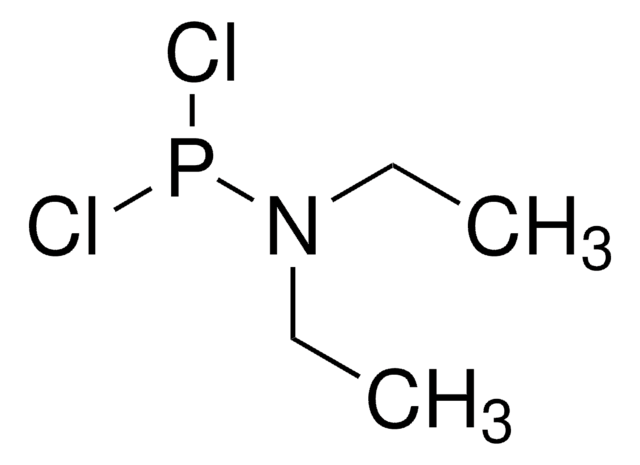According to The Sigma-Aldrich Handbook of Stains, Dyes and Indicators, Rose Bengal is soluble in water at 100 mg/mL, ethanol at 30 mg/mL and 2-methoxyethanol at 60 mg/mL. Conn's Biological Stains (10th Edition) states Rose Bengal has a solubility of 36% in water and 8% in ethanol.
Kluczowe dokumenty
330000
Rose bengal
Dye content 95 %, ≥96% (HPLC)
Synonim(y):
4,5,6,7-Tetrachloro-2′,4′,5′,7′-tetraiodofluorescein disodium salt, Acid Red 94, Bengal Rose B sodium salt, Rose Bengal sodium salt
Wybierz wielkość
567,00 zł
Wybierz wielkość
About This Item
567,00 zł
Polecane produkty
Poziom jakości
Próba
≥96% (HPLC)
Formularz
solid
skład
Dye content, 95%
metody
titration: suitable
kolor
red to brown
ε (współczynnik ekstynkcji)
≥ 3000 at 350-354 nm
≥12000 at 311-315 nm
≥32000 at 262-266 nm
≥32000 at 513-517 nm
≥98000 at 546-550 nm at 0.04 g/L (H2O + 1ml 1% Na2CO3)
Zastosowanie
diagnostic assay manufacturing
hematology
histology
temp. przechowywania
room temp
ciąg SMILES
[Na+].[Na+].[O-]C(=O)c1c(Cl)c(Cl)c(Cl)c(Cl)c1C2=C3C=C(I)C(=O)C(I)=C3Oc4c(I)c([O-])c(I)cc24
InChI
1S/C20H4Cl4I4O5.2Na/c21-10-8(9(20(31)32)11(22)13(24)12(10)23)7-3-1-5(25)16(29)14(27)18(3)33-19-4(7)2-6(26)17(30)15(19)28;;/h1-2,29H,(H,31,32);;/q;2*+1/p-2
Klucz InChI
UWBXIFCTIZXXLS-UHFFFAOYSA-L
Szukasz podobnych produktów? Odwiedź Przewodnik dotyczący porównywania produktów
Opis ogólny
Zastosowanie
Kod klasy składowania
11 - Combustible Solids
Klasa zagrożenia wodnego (WGK)
WGK 3
Temperatura zapłonu (°F)
Not applicable
Temperatura zapłonu (°C)
Not applicable
Środki ochrony indywidualnej
Eyeshields, Gloves, type N95 (US)
Wybierz jedną z najnowszych wersji:
Certyfikaty analizy (CoA)
Nie widzisz odpowiedniej wersji?
Jeśli potrzebujesz konkretnej wersji, możesz wyszukać konkretny certyfikat według numeru partii lub serii.
Masz już ten produkt?
Dokumenty związane z niedawno zakupionymi produktami zostały zamieszczone w Bibliotece dokumentów.
Klienci oglądali również te produkty
-
What is the solubility of Rose Bengal, Product 330000?
1 answer-
Helpful?
-
-
What types of applications can Product 330000, Rose bengal be used for?
1 answer-
According to the literature, Rose bengal has been used in a used in neutrophil adherence test and as a generator of singlet oxygen when exposed to laser energy. See: McKinnon, J. , Expt. Med., 164, 1864, (1986) and Gamble and Vadas, Science, 242, 97, (1988).
Helpful?
-
-
What is the Department of Transportation shipping information for this product?
1 answer-
Transportation information can be found in Section 14 of the product's (M)SDS.To access the shipping information for this material, use the link on the product detail page for the product.
Helpful?
-
-
What is the quantum yield of Rose bengal, Product 330000?
1 answer-
According to the literature, the quantum yield of Rose bengal is 0.11. See: Seybold, P.G., et al., Calorimetric, photometric and lifetime determinations of fluorescence yields of fluorescein dyes, Photochem. Photobiol., 9, 229-242 (1969).
Helpful?
-
Active Filters
Nasz zespół naukowców ma doświadczenie we wszystkich obszarach badań, w tym w naukach przyrodniczych, materiałoznawstwie, syntezie chemicznej, chromatografii, analityce i wielu innych dziedzinach.
Skontaktuj się z zespołem ds. pomocy technicznej









